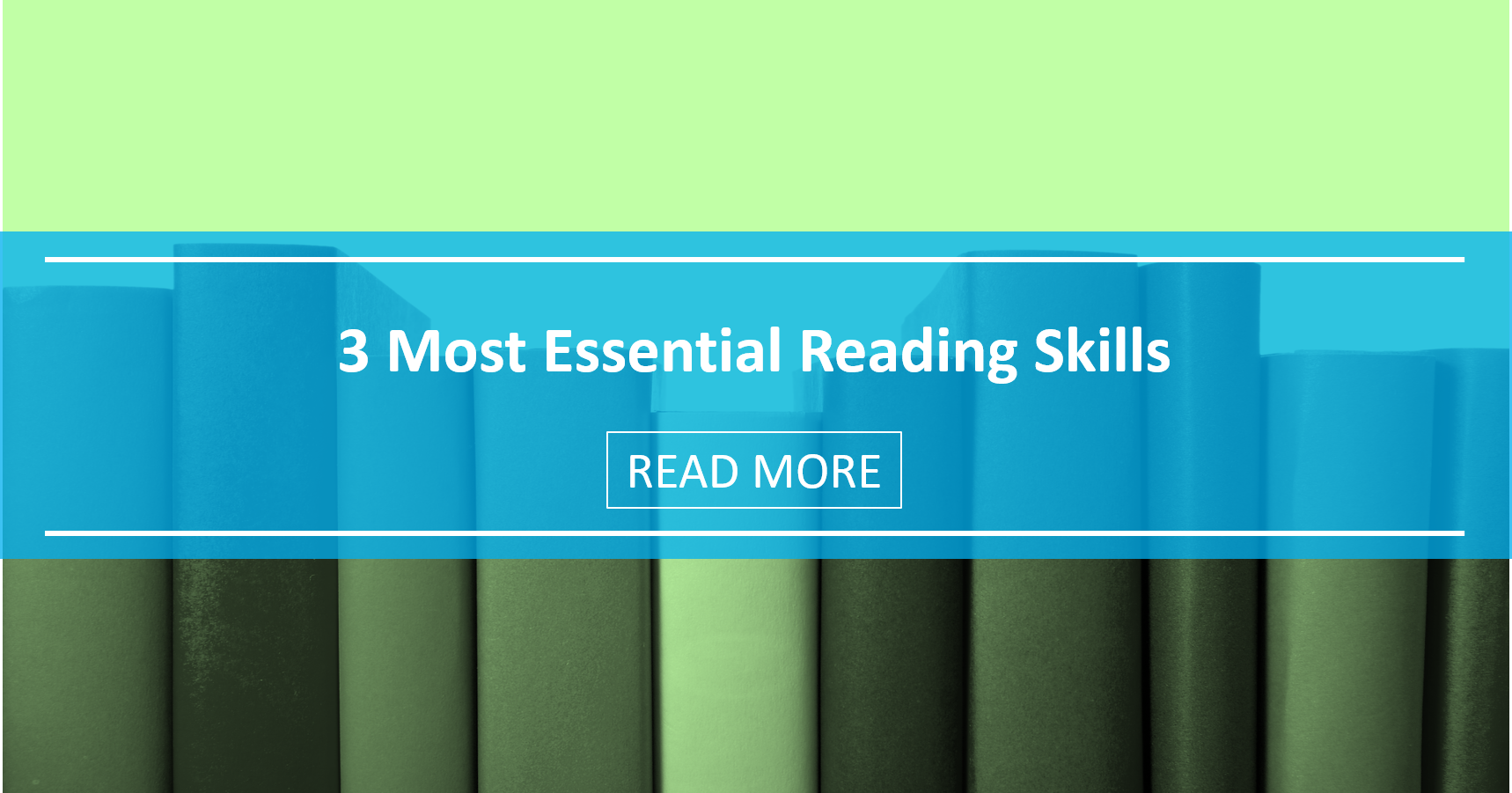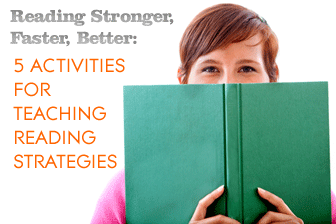3 Most Essential Reading Skills Your Students Need


How do you teach students to become better readers, especially with academic texts? As a teacher, you can arm students with specific reading strategies that will help students navigate and comprehend any given text. Below are 5 essential strategies and ways to use them in your classroom.
One of the most essential reading skills is scanning for specific information. By training students to scan the page to look for key words, they learn to group specific letters together and quickly identify words, thus improving their fluency over time. Scanning is also a critical test-taking skill that allows students to read questions carefully and know how to look back in the text quickly to find the answer.
Activities: A good scanning activity is a “running race.” To do this activity, prepare 9 or 10 questions about the details of a text; these questions should not be subjective but have one clear objective answer. This activity can work both before students read the text or as a review activity when students have finished the reading. Put students into pairs with each student having a copy of the text in front of them and make enough copies of the questions for each pair. Cut the questions so they are in strips of paper, and give each pair question number one only. When you tell students to start, they should race to find the correct answer to the first question, and then one partner should run their written answer to your desk to show you. If the student is correct, give them question number two, and so on until a group has answered all of the questions correctly. This activity works well with any text but can be especially challenging if you give students the classifieds section of the newspaper. For more advanced students, you can mix-up the order of your questions so that they do not follow in order with the text.
Another scanning activity is to do a “find the word” race. With the text in front of them, write down a word on the board that only occurs once in the text. When students find the word, they should stand up. Wait until all students are standing to have the first student point out the sentence that the word is in. A more challenging alternative is to only say the word aloud without writing it down. This is a good way to pre-teach vocabulary by drawing students’ attention to these words and discussing the meaning of these words. This activity also works as a way to preview the text as it can lead to a discussion of what the students believe the story will be about based on the words you select from the text.
Skimming is an essential skill because it previews the text for the learner. Just like knowing the topic of a conversation beforehand helps us be better listeners, knowing the main idea of a text is extremely beneficial before students begin to read closely. A general understanding of the broad topic will prepare them to read for understanding and allow them to read faster.
Activity: Have skimming activities where you copy the text, blocking out everything but the title, pictures, first lines of each paragraph, and the last paragraph. From this information, get your students to identify the main idea and why the author is writing this story. Have a discussion about what they already know about the text and what they think they will learn in the details.
Main idea is one of the most difficult skills for students because it’s one of the only test questions where the answer can’t always be found in an exact line within the text. Students need to be able to comprehend an entire text and then decide what is the big picture idea. While the skimming strategy described above helps students to determine the main idea before reading, the main idea strategy is for students to understand the “big picture” after reading the text.
Activities: Give students the “6W questions” to ask about the author’s purpose after reading an entire text. Who is writing this text and who did the author want to read this text? What is the author saying? Why is the author saying this? When did the author write this story? Where does this story take place? How did the author write this story? By getting the basics of the author’s purpose, we can more easily understand what the main idea is.
Alternatively, you can try the main idea builder after reading a text in its entirety. Ask students to close their books and tell you what this article is about in one word. For example, is we had just read a story about the ancient Mayan civilization and some of their customs, the one word response would be “The Mayans.” After giving you one word, then ask them to put more description on that one word, such as “Mayan civilizations.” Slowly add onto your description one or two words at a time until you get a full, complex sentence that highlights the main idea of the story. An alternative to this activity is to have students close their books, and then describe their article to a partner, but they must pretend that their partner has never read the story. You can also have students write a letter to their family member describing the story to them.
Another activity that emphasizes main idea is outlining. Give students a blank outline form that asks them to fill in the author’s thesis, main points, details, and examples. If the text you’re working with doesn’t lend itself well to the rigid structure of an outline, have students write down one sentence for each paragraph that expresses the main idea that paragraph. When they are finished, they should be able to put their main idea sentences for each paragraph together to find the main idea of the whole story.
Many times students are too reliant on their dictionaries; they use their dictionaries every time they encounter an unfamiliar word which disrupts reading fluency and sentence comprehension. A better and more realistic approach to help them master unknown words is discovering meaning through context. Context clues can be found in other words nearby and also from the grammatical structure of the sentence.
Activity: Choose a made-up word (for example, noubit ) and use it in many different contextual sentences, and ask students to determine the meaning of this non-word. Keep the same made-up word for each sentence, but use appropriate word endings to illustrate the change in part of speech (i.e. noubits, noubiting, nubition, nubitous, noubitously, etc…). Using the same non-word throughout the exercise will prevent them from relying on their dictionaries while also keeping them from thinking that this word is a real word. Your sentences should be rich with context so that students can determine the meaning, for example “The invention of the car has made transportation much easier. In the past, people had to use noubits to get around which took a long time.” Emphasize to the students that it’s not always necessary to get the exact, precise meaning of the word. For example, in the above sentence, “noubits” could be horses, bicycles, or feet, but any of those meanings will still allow them to comprehend the importance of the invention of the car. As long as students can understand the meaning of the sentence, that will be enough for them to finish reading, and they can look up the specific word in their dictionaries later. Also, some of your sentences should include grammatical clues, such as appositives, for example, “The task was so noubitous, or strenuous, for the students.” Take time to go over each question as a class so that you can model for your students how to identify and effectively use these context clues.
Like main idea, inferences can’t be found directly in the lines of the text; you must teach your students to read between the lines. Being good at making inferences relies a lot on critical thinking skills which can be a difficult thing to teach.
Activity: Using riddles with your students is a good way to illustrate the importance of inference. Start with something simple like, “I love my job. I go to the hospital everyday, and I take care of my patients. What am I?” Students should easily be able to identify the description of a doctor/nurse. Ask them how they knew that when you never explicitly stated what your job was. Similar to the context clues example above, students may have similar but different answers, such as a doctor and a nurse. Many times we won’t be able to identify exactly what the author is inferring, but if we can determine something that retains the main meaning, we can still understand the text appropriately. As students progress, give more challenging riddles.
Another activity to do is to find short mystery stories or “whodunit” stories. The very old book series Encyclopedia Brown works great for this reading skill, and there are countless others to be found on the web. These activities will teach your students close reading skills and force them to think critically about what is both in and not in the text, thus helping them become better at inferences.
Model and practice these skills with your students regularly and watch over time how they will be reading stronger, better, and faster!